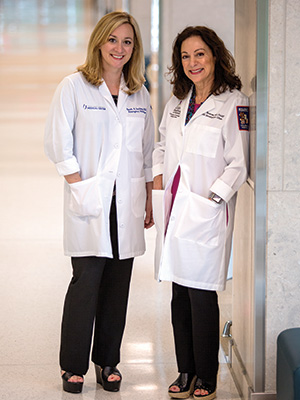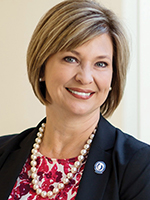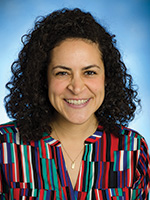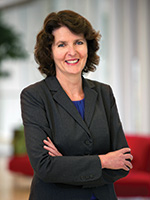More women accepted as medical students, physicians – but the work isn’t done

EDITOR’S NOTE: This is a slightly edited reprint of an article originally published in the Summer 2018 edition of Mississippi Medicine, the magazine for School of Medicine alumni. The breakdown of the medical school class by gender applies to the latest group of students admitted at that time, the Class of 2021; those students are now in their second year.
Keep in mind that on the day Sela Sterling met her mom’s boss, Sela was around 4 years old.
Keep in mind that Sela’s mom is a physician, Dr. Sarah Sterling. That Sela’s grandmother is also a University of Mississippi Medical Center physician, Dr. Susan Buttross. That Sela’s friend’s mother is a physician. And that a woman is Sela’s dentist.
In that case, perhaps it’s understandable what Sela did when her mother introduced her to Dr. Richard Summers, UMMC associate vice chancellor for research and professor of emergency medicine.
“‘Mom, he can’t be a doctor,’” she said. ‘He’s not a girl.’”
While Sela’s opinion was only half-true, it illustrates that, within a very young generation at least, long-held attitudes toward women are changing – an about-face that is especially resonant in September, Women in Medicine Month, when the American Medical Association Women Physicians Section honors physicians who have supported women with medical careers.

As Sela’s grandmother, Dr. Susan Buttross, Class of ’77, will testify, there was a time when the prevailing opinion was more like: “She can’t be a doctor; she’s a girl.” That presumption practically lies on its deathbed now – at least in medical schools.
Some 40 years after Buttross earned her M.D. in a class graduating 20 women and 91 men, the University’s School of Medicine Class of 2021 enrolled 83 women and 72 men; this is, apparently, the largest female-to-male ratio, by far, in the school’s history.
It was only the second time female matriculants out-numbered males and reflected a national trend.
X-FILES X-FACTOR

Dr. LouAnn Woodward, vice chancellor for health affairs and dean of the School of Medicine, reported this enrollment milestone during an alumni event in the summer of 2017. More recently, she noted that “the majority of the time, the ratio has been closer to 60-40 for men.”
It’s not just the numbers, but also the nature of medical schools that has changed, even since 1991, the year Woodward graduated here as one of only 23 women in a class of 93.
“Since then, the LCME has adopted standards about mistreatment of learners and about a positive learning environment; it’s also highlighted professionalism,” said Woodward, referring to the Liaison Committee on Medical Education.
“We were not having these conversations when I was a resident,” said Woodward, who trained at UMMC in emergency medicine. Such conversations, she said, may be encouraging more students to seek careers in medicine – men as well as women.
This school does not educate in a matriculation vacuum. In December 2017, the Association of American Medical Colleges reported that in all U.S. medical schools for the fall of that year, women represented 50.7 percent of the 21,338 new enrollees. Women had never outnumbered men before.
Many reasons, or theories, may explain the change, one of which is “the Scully Effect” – the idea that more women have been drawn to careers in science, technology, engineering and math because of the example set by the fictional TV character, Dr. Dana Scully, especially during the original run of “The X-Files” from the early 1990s until 2002.
Nonfictional research may back this up: The findings of a survey released this year show that women who watched the series regularly were 50 percent more likely to have a STEM (science, technology, engineering, mathematics) job; almost two-thirds of those named Scully as a role model, reports the Geena Davis Institute on Gender in Media.
MIRROR IMAGE

“Expectations of women are changing,” said Dr. Sarah Ali, Class of 2016, now an internal medicine resident at Kaiser Permanente Medical Center in San Francisco. “They want to be more than society once told them they should be. I believe it was bound to happen.
“But I’m a little bit biased in this,” said Ali, a Hattiesburg native. “I believe the ability and tendency to take care of others is part of women’s genetic makeup, so it’s natural that you would make it part of your professional career.”
For that reason, people should not be taken aback as more and more women choose to study and practice medicine, said Dr. Loretta Jackson-Williams, UMMC vice dean for medical education and professor of emergency medicine.
“It’s fascinating to me that anyone should be surprised. Some people are, I believe, because of history; but history doesn’t tell you where you’re going; it tells you where you’ve been. The evolution of women in medicine is natural; this is the way it’s supposed to be.”
This brand of evolution was not spontaneous or haphazard.

“For a while, we’ve had goals to put more women, as well as underrepresented minorities, in the physician workforce,” said Dr. Alison Whelan, the AAMC’s chief medical education officer. “It should mirror the society we see.
“Women have been encouraged, in high school and universities, to think about the medical profession, and the sciences in general, as a career. There are social media campaigns, such #ilooklikeasurgeon” she said of the three-year-old Twitter movement to celebrate diversity in what has been a male-dominated field.
“But I don’t believe the work is done. We’re close to parity. But if we don’t continue to work, to recruit, the numbers could slip again.”
‘THE CRAZIEST THING’
When Buttross was growing up, she didn’t expect to be recruited; she just wanted to be validated, which she was – but often, and in varying degrees, when she was close to home.
“When I told my grandfather I wanted to be a doctor, he just laughed,” she said. “He thought it was the craziest thing that this little curly-headed girl was going to medical school; but when I did, he was proud.”
Those who did encourage her from the beginning, including her father and her science teacher at Canton High School, are partly responsible for a certain high-profile career.
A professor of pediatrics and medical director of the Center for the Advancement of Youth, Buttross has a voice of experience that carries for miles: She is the host of “Relatively Speaking,” part of Mississippi Public Broadcasting’s daily lineup of call-in radio shows promoting wellness. That voice was sometimes talked over, or dismissed, at one time.
“I’ve seen attitudes evolve a lot over the years,” said Buttross, who did her residency at UMMC and the University of Texas Medical Branch in Galveston. “Now I hear individuals say, not only do they accept having a women as a physician, but they almost prefer it.
“I’ve heard some men and other women say they love their women doctors. Which was not always the case.”
Practically all of those interviewed for this article made a point of saying they did not want to “sound negative,” or to be seen as a “complainer.” But the reception female physicians and students have encountered, from patients and some colleagues and faculty alike, may be part of the reason men have dominated the medical profession.
It began with the medical school interview, said Buttross, who was admitted in 1973. “For a time, I believe there was a bias toward the six-foot man over a five-foot-two woman. There was this opinion that women didn’t have the stamina – the emotional as well as the physical – to follow through and be a full-time practicing physician.”
The presumption pursued her into medical school. “I felt like there was this view that I needed to prove that I could be just as good a doctor as a man could be,” Buttross said. “And it was assumed that women might not practice once we graduated or had children. Sometimes this was verbalized: ‘There are plenty of other things you can do if you just want to find a doctor to marry.’”
Buttross preferred to be one. “I was determined to have a family and I always knew I wanted to be a physician,” she said. “But did I get discouraged because I was tired a lot of the time? Yes, but did it make me want to turn away? I would say, ‘no.’
“I believe that then it was harder to have a successful marriage and a successful career; I hope it’s better now.”
During her residency, at UMMC and in Texas, men were among those who were “very encouraging,” she said; a particularly prominent one was Dr. Blair Batson, now professor emeritus of pediatrics.
Still, the patronizing persisted. “I was shocked when somebody in the medical field, someone I admired, asked me if I planned to quit after I had my first child,” Buttross said.
“There wasn’t a whole lot of talk about men and women sharing equally in marriage. There was talk of women’s liberation, but the reality was if you were working full-time, even if you were a medical student or resident, the person primarily responsible for taking care of the children, for taking off when a child was sick, for doing the cooking and cleaning, was still the woman.
“Now, I don’t see that so much.
“But back in the day, the assumption from all sides was that the woman’s place was in the home bringing up a family, and if you weren’t there you were doing a disservice to them. I’m happy to say I have five well-adjusted children.”
‘YOU DON’T LOOK LIKE A DOCTOR’
Among Buttross’ children is Sterling, whose Class of 2008 numbered 49 women and 49 men – none of whom questioned her motives or her right to be there, she said.
Now an assistant professor of emergency medicine at UMMC who did her residency here, she said her mother’s career had a “huge impact” on her own decision to become a doctor.
“Through her, I saw that it could be done, and done successfully,” said Sterling, who was honored in 2017 by the Group on Women in Medicine and Science with the Rising Star Award, recognizing women in UMMC schools for their early-career achievements and potential.
As for her own daughters, Sela, who once believed that only girls could be doctors, is now 8 and wants to be an artist; Evelyn, 4, seems set on emulating her mom who, as a girl herself, “made sure my stuffed animals would always have to come to my clinic to get their legs wrapped,” Sterling said.
“‘You can’t do that because you’re a girl’ – that did not exist in my family.” Outside her family, though, it’s a slightly different matter.
“I don’t believe I’ve had any patients who didn’t want me to be their doctor,” Sterling said, “but some have said, ‘You don’t look like a doctor.’ In general, if I experience any condescension from colleagues, it’s much more subtle.
“I've never experienced anything like my mother did years ago, from patients or colleagues.”
Others made similar claims: For instance, an idea already expressed by a woman may be taken more seriously if raised by a man. And the adjective “brilliant” is virtually gender-specific – the specific gender being male.
It’s some of the patients, though, who have struggled most to discard old notions.
WAVING THE WHITE COAT

“I always put on my white coat for the clinic, not because I’m cold, but for patients,” Jackson-Williams said. “However, even then, if there is an initial response from some of them, it’s not ‘Hello, doctor.’ It’s: ‘Are you here to take me for my X-ray?’
“It’s not about breaking the stereotype within the profession; it’s about breaking a societal stereotype. That will take a while.”
Some patients see a woman in a white coat and assume she’s a nurse, said Dr. Ashley Pickering of Belmont, an ophthalmology resident at LSU-Shreveport who graduated from the School of Medicine in May.
“That doesn’t bother me, but it does bother some people. Also, older male patients will request a male doctor sometimes. But, not every patient is going to fit with the personality of every physician. Some women feel more comfortable talking about certain things with other women, and some men feel more comfortable talking about certain things with other men.”
For her part, Ali said she was never “talked down to” by, or felt different from, her male counterparts during her four years in medical school. But she did see some older male patients who “talked to me as if I were a little girl.
“That’s bound to happen. Not that I don’t respect them or the time they lived in. Now, we’re in a time when we are empowered, and don’t feel reluctant to say something, even though you don’t want to interfere with the relationship with your patients.
“It’s OK, though. You can use those experiences to make yourself stronger. They’re a reminder of what we have accomplished and where we are heading. And that should be encouraging to women as well.”



